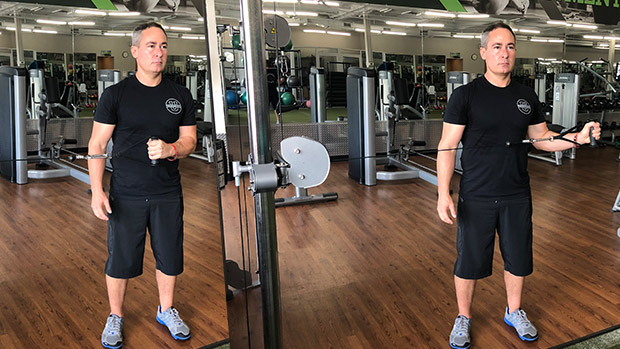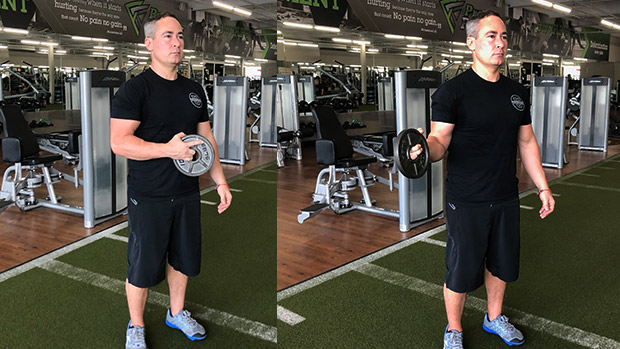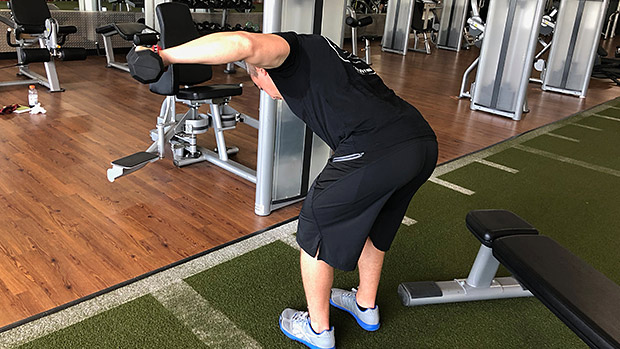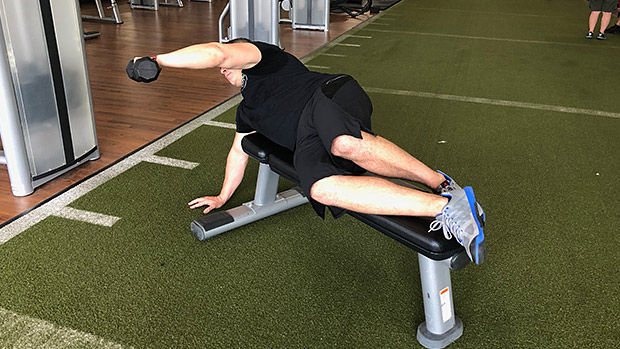Most trainers think that your weekly workouts are pretty much complete as long as you perform exercises that address these movement patterns:
- A horizontal pressing movement
- A horizontal pulling movement
- A vertical pressing movement
- A vertical pulling movement
I don't disagree, but my recommendations are a little more comprehensive. As I wrote in Lost Strength: The Missing Exercises, a complete workout also requires single-leg exercises and cross-body exercises.
But that's not all. We also need to further break down the four basic movement patterns into vertical, diagonal, and horizontal pushing and pulling movements. A complete program should incorporate all of these variations. Why? Because pressing and pulling in different directions creates a slightly different loading stimulus (e.g., flat dumbbell press vs. incline dumbbell press).
That's where isolation work comes into play. It allows you to target muscles that most exercises don't touch. Here's a checklist of upper-body isolation exercises you need to do each week to make sure your strength workouts are more complete.
Horizontal pressing exercises like bench presses and push-ups effectively strengthen the pecs when they're in their mid to lengthened range. However, they don't strengthen the muscles when the pecs are in their shortened range, like when the arms are straight out from the torso. In that position, you're no longer working against a force that's pulling your arms apart.
This is why you need to also perform cable pec flyes (single-arm version in video) or machine pec flyes. They make you work against a resistance that's pulling your arms apart when they're extended away from the body. This is a range that's often neglected by traditional multi-joint pressing exercises.
Double-arm cable flyes do an even better job than the machine flyes because the cable allow you to cross-over your arms at the finish and get an even greater range of motion.
Horizontal pulling exercises such as bent-over rows, dumbbell rows, seated rows, and machine rows mainly train the action of shoulder extension.
However, to strengthen horizontal shoulder abduction you need to add exercises like wide-grip rows, face pulls, dumbbell rear-delt flyes, or machine rear-delt flyes. Face pulls work the best because they also train shoulder external rotation.
The exercises in the previous section do a great job of loading you when your arms are out to the sides (when the posterior shoulder musculature is in a shortened range), but they neglect to strengthen the aspect of horizontal shoulder abduction when your arm is in front of, or across, your torso – when the posterior shoulder musculature is in a mid to lengthened range.
This is where exercises such as cable crossover rear-delt flyes and side-lying dumbbell rear-delt flyes are useful. They strengthen a range of motion neglected by the exercises in item two in our checklist to create what I call "full-range strength."


Many upper-body pushing exercises, as well as several pulling movements, train the shoulder internal rotators. However, most people neglect to do any external rotation work for the shoulders.
And if they do any work, they usually do that movement where they stand upright while holding one or two dumbbells with their elbows at a 90-degree angle and flap their arms slowly like a tranquilized chicken. This exercise is really just an isometric biceps curl. Sure, you're internally and externally rotating your shoulder, but you're not sufficiently loading the rotator cuff muscles because you're working with gravity, not against it.
To sufficiently load (both concentrically and eccentrically) the external rotators of your shoulder with your elbows by your side while standing, you have to create a horizontal load vector by using a cable or band that's set at roughly the same height as your elbow. You can use gravity to create a similar load vector by doing external rotations with a dumbbell while lying on your side.
Now, some trainers assert that targeted shoulder external rotation exercises are essentially a waste of time, but research has shown that isolated external rotation – either side-lying with a dumbbell or done standing with cable or tubing resistance – produces significant supraspinatus and infraspinatus muscle forces (9).
Add some shoulder Y's with your torso parallel to the floor. They train the top end of the shoulder flexion movement (when your arms are overhead), which isn't addressed by vertical pressing exercises.
I prefer to do the exercise moving one arm at a time because it's much harder to cheat this way. Of course, doing them unilaterally is more time consuming, so try doing iso-dynamic reps, which involve holding one side isometrically while performing normal reps on the other side, as shown in the video.
Most multi-joint pushing exercises also involve a contribution from the triceps. However, these exercises predominantly train the triceps in their mid to shorten-range position. This is why you need to include focused elbow extension exercises that place the most mechanical tension of the triceps in the lengthened range. Exercises that do this include overhead dumbbell triceps extensions or overhead rope triceps extensions.
For the overhead rope triceps extensions, the cable (the force vector) should be positioned at or below shoulder height and performed with a forward torso lean to maximize the tension in the stretched range.
Most multi-joint upper-body pulling exercises predominantly train the biceps in the mid to shortened-range position. To increase your strength, do exercises like preacher curls and what I call "face-away cable curls."
Let's talk about the full range of motion myth, which is the false belief that moving through the full range of motion involved in a given exercise means you're effectively strengthening through that entire range of motion.
This is false because all exercises that involve free weights and cables have a point within the range of motion (ROM) where the exercise is hardest on the muscles involved, and another point where the exercise is the easiest based on the lever-arm (i.e. moment arm) involved.
When it comes to upper-body exercises, the exercise is hardest – creating the most load on the involved muscles – when your humerus is at a 90-degree angle to the force vector (gravity or the cable), because this is the point in the range of motion where you have the least mechanical advantage.
The farther away you get from the 90-degree angle – the closer your humerus gets to being parallel to the force vector – the less load you place on the involved musculature.
To demonstrate, let's compare the standard dumbbell rear-delt flye (bent-over with your torso roughly parallel to the floor) to the side lying rear-delt flye.


Sure, they're both done by lifting your arm out to the side (horizontal shoulder abduction), but the mechanical tension that's created on the involved musculature relative to the range of motion is very different.
When performing the standing dumbbell rear-delt flye, the most mechanical tension occurs when your arms are extended out to the sides. However, it doesn't build strength in the range of motion when the arms are hanging straight down from your bent-over torso.
On the flipside, when performing the side-lying dumbbell rear-delt flye, the situation is reversed. That exercise places the most mechanical tension on the involved muscles when your arm is extended out in front of your torso, but doesn't strengthen your posterior shoulder musculature when your arm is out to the side of your torso (pointing at the ceiling). So, you need to do both exercises.
This is an important principle that applies to all strength training exercises because strength gains are extremely joint-position specific (1,2,3,4,5,6,7,8). In other words, the principles of biomechanics, overload, and specificity, along with the scientific evidence just provided, clearly demonstrate that you don't get stronger in positions and movements you don't train in.
Therefore, isolation exercises are needed to fill in the strength gaps left over by multi-joint exercises.
- Lindh M. Increase of muscle strength from isometric quadriceps exercises at different knee angles. Scand J Rehabil Med. 1979;11(1):33-6. PubMed.
- Thépaut-Mathieu C et al. Myoelectrical and mechanical changes linked to length specificity during isometric training. J Appl Physiol (1985). 1988 Apr;64(4):1500-5. PubMed.
- Kitai TA et al. Specificity of joint angle in isometric training. Eur J Appl Physiol Occup Physiol. 1989;58(7):744-8. PubMed.
- Weir JP et al. Effects of unilateral isometric strength training on joint angle specificity and cross-training. Eur J Appl Physiol Occup Physiol. 1995;70(4):337-43. PubMed.
- Ebersole KT et al. Mechanomyographic and electromyographic responses to unilateral isometric training. J Strength Cond Res. 2002 May;16(2):192-201. PubMed.
- Folland JP et al. Strength training: Isometric training at a range of joint angles versus dynamic training. J Sports Sci. 2005 Aug;23(8):817-24. PubMed.
- Noorkõiv M et al. Neuromuscular adaptations associated with knee joint angle-specific force change. Med Sci Sports Exerc. 2014 Aug;46(8):1525-37. PubMed.
- Noorkõiv M et al. Effects of isometric quadriceps strength training at different muscle lengths on dynamic torque production. J Sports Sci. 2015;33(18):1952-61. PubMed.
- Pabian PS et al. Postrehabilitation Strength and Conditioning of the Shoulder: An Interdisciplinary Approach. Strength & Conditioning Journal. 2011 Jun;33(3):42-55.





